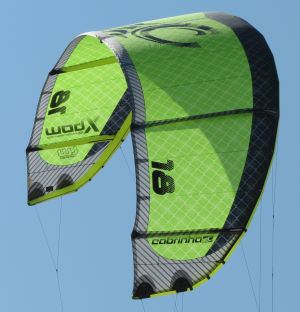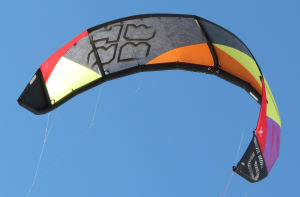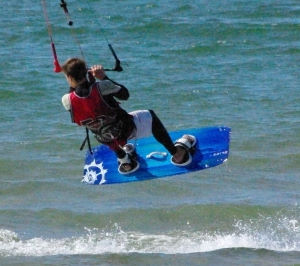How to Kiteboard in Light Winds
 How to Kiteboard in Light Winds
How to Kiteboard in Light Winds
While kiteboarding already has a huge lightwind advantage over sports like windsurfing, everyone always wants to get the most riding time possible. For most kiteboarders on a standard setup (12m Kite & 140cm board for 175lb rider), rideable wind begins at about 15 mph. This amount of wind is apparent because whitecaps become easily seen and prevalent on the water around 15 mph. With this same setup, jumping and powered riding will begin at around 17 mph.
One of the best things you can do to improve your lightwind riding is to become a better kite flyer. Accomplished kite flyers can lose as much as 3 mph of wind and still be riding because they keep the kite moving in the power zone. A good way to become a better kite flyer is simply to fly in light-winds. You can learn more in an hour of flying your kite in sub-12 mph winds than all your previous experience combined. It is much more difficult to fly the kite in these winds and it is necessary to keep the kite moving.
Tip: Remember to pull in for more power when turning, then let the bar out to allow the kite to become more aerodynamic and rise in the sky.
 I don't want to sound like the salesman here, but If you want to fly in very light wind, you need to make some additions to your quiver. A 16m or larger kite will give you the power needed to fly on those sub-15 mph days. Kites like the Cabrinha Crossbow LW, Best TS 17m, and Slingshot Turbine are designed to give low-end grunt and upwind excellence. While kite skill helps, a huge kite is still necessary if you want to get anywhere near 10-12 mph and riding. As a more experienced rider, I always thought that lightwind riding was just for racers or tourists, but this summer I had my eyes opened by the Best TS 17m. At just 15 mph I was able to unhook and complete some serious tricks. It provided power like my 12m kite in 20 mph and was more stable to boot. I ended up getting numerous fun sessions on days that I normally would have written off as "just rideable". I have readjusted my personal quiver to include a lightwind kite because we get more 12-16 mph days in Michigan than we do 20-30 mph. So really it makes more sense to have a 17m and 12m than it does a 12m and 9m.
I don't want to sound like the salesman here, but If you want to fly in very light wind, you need to make some additions to your quiver. A 16m or larger kite will give you the power needed to fly on those sub-15 mph days. Kites like the Cabrinha Crossbow LW, Best TS 17m, and Slingshot Turbine are designed to give low-end grunt and upwind excellence. While kite skill helps, a huge kite is still necessary if you want to get anywhere near 10-12 mph and riding. As a more experienced rider, I always thought that lightwind riding was just for racers or tourists, but this summer I had my eyes opened by the Best TS 17m. At just 15 mph I was able to unhook and complete some serious tricks. It provided power like my 12m kite in 20 mph and was more stable to boot. I ended up getting numerous fun sessions on days that I normally would have written off as "just rideable". I have readjusted my personal quiver to include a lightwind kite because we get more 12-16 mph days in Michigan than we do 20-30 mph. So really it makes more sense to have a 17m and 12m than it does a 12m and 9m.
 Another invaluable tool in lightwind riding is a large board. A lightwind specific twintip like the Cabrinha Stylus, Best Breeze or Slingshot Glide are perfect for expanding your wind range. These large, flat twintip kiteboards allow for easier planing and keep your momentum during lulls in the wind. Big guys will also love these boards for a standard ride as long as they stay away from heavy chop.
Another invaluable tool in lightwind riding is a large board. A lightwind specific twintip like the Cabrinha Stylus, Best Breeze or Slingshot Glide are perfect for expanding your wind range. These large, flat twintip kiteboards allow for easier planing and keep your momentum during lulls in the wind. Big guys will also love these boards for a standard ride as long as they stay away from heavy chop.
An alternative to a lightwind twintip is a kite surfboard, preferably a wider fish design. Boards like the Slingshot Dialer, Slingshot Knee Swacker, and Cabrinha Subwoofer are as inexpensive as $369 and offer the most fun you can have in light wind or small waves. The large surface area and surf style fins make getting upwind easy, while the surfy outline and speed make them an enjoyable change. Not only do these boards work well in light wind, but also in waves under 6' and as a traditional surfboard on those days without wind. Riding these boards in light wind will open your eyes to the fun of riding strapless surfboards while you hold your own against your friend's race board.
If you are looking to score some more sessions or just extend your current sessions, grab some lightwind gear and meet me on the water for some of the most uncrowded and beautiful sessions of the year!
Tucker Vantol
Riding 1 year
Intermediate wakestyle and strapless surf
Age: 26
Weight: 175
